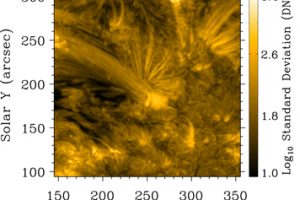Nanoflares and the heating of solar corona. The study: “Statistical Signatures of Nanoflare Activity. I. Monte Carlo Simulations and Parameter-space Exploration” of D. B. Jess (Queen’s University Belfast) recently appeared on ApJ.

There are still secrets of our Sun that the scientific community struggles to unveil. One of this is the mechanism responsible for the heating of solar corona. While the photospheric plasma has a typical temperature of about 5700 degrees, in fact, the plasma in the solar chromosphere and corona is hotter: about 10000 degrees in the chromosphere and 1-2 millions degrees in the corona. There should be some mechanism at work, then, capable of efficiently heat the plasma in the solar atmosphere up to several million degrees.
Proposed mechanisms typically involve the solar magnetic field. Coronal plasma is, in fact, at a low density (108-109 times more rarefied than in photosphere) and highly ionized. In these conditions, the magnetic field dominates the dynamic of the plasma and the evolution of the corona and its active regions (X-rays and UV bright regions of the corona with plasma temperature in excess of 10 million degrees). One of these mechanisms are nano-flares. Flares are among the most energetic phenomena occurring in the Sun, triggered by a rapid release of energy by the magnetic field after a rearrangement of its topology. Part of this energy is deposited on the underlying photosphere, heating the plasma locally up to million degrees and make it evaporate filling the coronal loops above.
Studies on solar flares show that the flares frequency over their energy (dN/dE) is a power-low of the energy (dN/dE∼E-α). If α is ≥2, then the frequency of nano-flares is high enough to produce a substantial heating of the solar corona. However, nano-flares do not produce effects that can be resolved by present-day instruments observing the Sun. The study: “Statistical Signatures of Nanoflare Activity. I. Monte Carlo Simulations and Parameter-space Exploration” of D. B. Jess (Queen’s University Belfast; California State University Northridge), recently appeared on “The Astrophysical Journal”, describes simulations of a series of nano-flares performed adopting a Monte Carlo method. The resulting intensity maps are then analyzed and used to analyze real images of the coronal active region NOAA 11366 obtained with the Solar Dynamic Observatory (SDO). This approach allowed the authors to estimate the power-law index α between 1.8 and 1.9, which does not support that nano-flares are the main phenomena responsible for the heating of coronal plasma. This study, thus, has important implications on our theory on the heating of solar corona. F. Reale (UNIPA/OAPA) is a co-author of this paper.
The figure (link) shows a SDO image of the active region studied in this paper.
